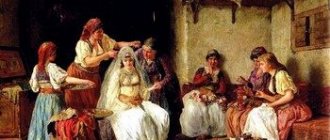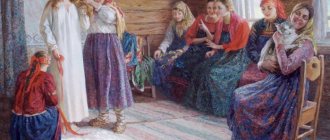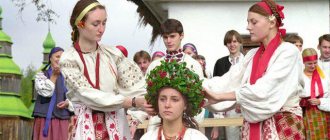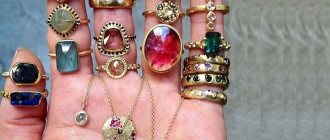For a long time in Rus' there was a tradition according to which it was customary to meet the newlyweds with bread and salt. The parents did this. Now this custom has been transformed. Previously, it had a different form. The meeting of the bride and groom with a loaf of bread was considered in Rus' a necessary condition for marriage.
The newlyweds were supposed to go to permanent residence with the groom's parents after the wedding. And already there the betrothed’s mother, her sisters and father met the young family, presenting them with a loaf of bread. They thereby wished for a good life, which would be much better than theirs.
Customs of meeting newlyweds with a loaf
Nowadays, the tradition of greeting people with bread and salt has changed. No one lives with their parents anymore and weddings are no longer held at home. It is important to note that this custom is so popular with newlyweds that it still exists even at modern weddings .
Mom meets the newlyweds in a cafe or restaurant. She is the very first one with a loaf of bread at the threshold. The task of the young spouses is to break off several pieces from the loaf. The one who has the largest piece will be the main one in the house. And the partner who has a small piece left will obey.
On the one hand, by refusing certain rituals, you can lose the originality of the wedding celebration. On the other hand, it is convenience and comfort. Mom and dad do not need to go home immediately after the wedding celebration. Of course, all this simplifies the organization of the wedding ceremony.
In addition, think that not only the young couple, but also the entire wedding procession, comes to the house of the groom’s parents. And as usual, according to hospitable traditions, they need to be fed and treated to champagne. If you remove this part, you can save money and give it to a young couple.
Loaf at a wedding, traditions, text.
Before conducting the bread and salt ritual, parents should prepare and purchase in advance:
- loaf;
- towel;
- icon.
Previously, it was customary to bake a loaf yourself. Now almost no one does this. Mostly everything is ordered from bakeries. After a wedding, many families wonder what to do with the loaf.
There are several options for this question:
- You can give it to young spouses.
- Cut in half and distribute between the parents of both the bride and groom.
- Give to guests at the wedding reception.
The groom's parents will have to decide which option to choose, since they will be the ones preparing the loaf for the wedding ceremony. Basically everything is given to the newlyweds. This is a very tasty bread with sweet notes. Therefore, the next day you can eat it with pleasure, washed down with tea.
In addition to the loaf itself, it is worth taking care of the towel. It is a towel embroidered in Russian folk style.
Please note that the ritual with a loaf is called “bread and salt”. Therefore, there is no way to do this custom without the salt itself. Special bread is baked with a depression in the middle. This is where the salt shaker is carefully inserted. The young people pinch off a piece of bread and dip it in salt. A meeting with a loaf of bread at a wedding is always held in the presence of guests.
Before performing the bread and salt ritual, parents must bless the newlyweds. To do this, take an icon with you and read a special prayer.
Often the toastmaster conducts the loaf ceremony, but she is in charge of the organization itself. Her responsibilities include meeting the newlyweds, arranging the rest of the guests, and asking the photographer to organize the shooting.
And the ceremony itself should be carried out by the parents. It is their words of love and support that their newly married children are waiting for.
Hospitality is a tradition
The Russian people have always been distinguished by their hospitality and cordiality.
The attitude towards guests in Rus' was special. Guests, even random ones, were treated with honor and respect. It was believed that the traveler who looked into the house had seen a lot on his way, knew a lot, and had a lot to learn from him. And if the guest enjoys the warm welcome, then from his words the good fame of the owner of the house and of Rus' will spread throughout the world. The main task of the owner was to feed his dear guest as best as possible; the best dishes were presented to him. The sayings “What is in the oven, everything is on the table”, “Even though he is not rich, he is glad to have guests”, “Don’t feel sorry for the guest, pour him thicker” have survived to this day. If the upcoming meeting of guests was known in advance, then preparations began several days in advance. There was a custom to greet dear guests at the doorstep with bread and salt. Usually the bread, always placed on a clean towel (rushnyk), was brought out to the guests by the hostess of the house or the woman whose hands the loaf was baked. At the same time, the towel indicated the path that the guest had taken. In addition, it symbolized God's blessing. Bread and salt were symbols of wealth and well-being, and salt was also attributed the properties of a “amulet.” To greet a guest with “bread and salt” meant to invoke God’s mercy on him and add your wishes for goodness and peace. However, guests could also bring bread and salt into the house, expressing special respect for the owner and wishing him prosperity and prosperity.
“Every traveler was, as it were, sacred for the Slavs: they greeted him with affection, treated him with joy, saw him off with reverence...” - N.M. Karamzin.
Words on a loaf from parents at a wedding
As a rule, it is the mother who holds the loaf. This is due to the fact that a woman is considered the main one in the house in terms of coziness, comfort and food. She cooks, cleans and raises children. She has a huge responsibility. Therefore, she must keep a delicious loaf and treat it to the young.
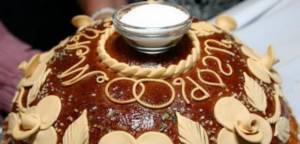
Meeting of the newlyweds with the icon, words from the groom’s mother.
At the same time, the father does not stand idle. He has a tray of drinks in his hands. After the spouses take a bite of the loaf, they are invited to drink from a jug. It is prepared in advance and serves to seal the alliance. How do parents greet newlyweds with a loaf of bread?
From the groom's parents
What should you say to the groom's parents at the wedding? Before making a speech in front of the loaf, mom comes out with an icon and asks the bride and groom to kiss the shrine.
She says a prayer and asks God to make the lives of her children turn out in the most beautiful and harmonious way possible.
- My dear guys, may your life only become more beautiful and richer day by day. Try our loaf, and let your life work out. Take a bite for your sweet daughter and little son. Our loaf is as sweet as your entire future life. There are no flaws in it, just like there are no flaws in your relationship.
- Dear children, accept a delicious and sweet loaf from our family to yours. May he fill your life with happiness, wealth and a favorable atmosphere. I would like to wish you love, harmony and boundless happiness.
From the bride's parents
Who brings a loaf of bread to the newlyweds at a wedding? Not only the groom’s parents, but also the bride’s mother make touching speeches during the bread and salt ceremony.
- Newlyweds, today is a happy day for all of you. Before you taste the loaf, I would like to give you an instruction. Love each other, take care and hold tight. And of course, don’t forget about us, your parents. We will pray for your family and hope that it will become big and strong.
- Guys, try the delicious bread soon. And let it become the key to health and family longevity. Be sure to share a piece with the people closest to you. The loaf is charged with positive emotions. This means they will definitely happen to those you love.
And today we meet with “bread and salt”
Our people are still open, hospitable and welcoming.
And the tradition of greeting dear guests not only with a welcoming word, but also with bread and salt has been preserved to this day. For example, on the wedding day, the mother of the groom presents the newlyweds with a wedding loaf - a symbol of pure thoughts and good intentions. This means that the parents accept a young wife into the family, with whom they now have to live next to each other and share all the troubles and joys. Of course, in its pure form, the ceremony is more often used at official meetings or at festive, solemn moments. For example, residents of the city greet their dear guests with a festive loaf of bread.
Poems for newlyweds
If you want to look original when meeting a young married couple, then you can prepare several simple quatrains for them. They should not have a complex rhyme.
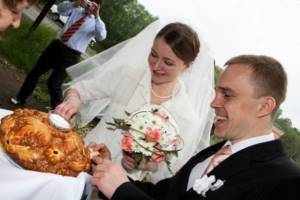
Congratulations on the wedding: bread and salt.
Make them as light and simple as possible. Poems about a loaf for a wedding:
Dear children, Try our loaf. He is magical, unearthly. Look how handsome he is. May our sweet treat. Bring you more patience. After all, it will depend on him what it will be like for you to live together. Love and laugh, Have fun and live.
Homemade loaf
Ingredients:
- Wheat flour 750 grams;
- Milk 300 milliliters;
- Butter 200 grams;
- Chicken eggs 4 pieces;
- Table salt 1 teaspoon;
- Sugar 5 tablespoons;
- Dry yeast 10 grams;
General information:
- Cooking time: 8 hours;
- Number of servings 1.
Cooking method:
- Let's prepare the ingredients for this great homemade bread: wheat flour, sugar, milk, butter, chicken eggs, salt and dry yeast (can be replaced with fresh - 30 grams). First of all, let's take 150 milliliters of milk, a couple of tablespoons of granulated sugar, yeast and 4 tablespoons of wheat flour.
- Add yeast and sugar to warm (no more than 38 degrees) milk, mix and add sifted flour. You should get a mass with the consistency of sour cream - this is called dough. We will leave it warm for 40–45 minutes.
- In the meantime, let's get to the rest of the ingredients: leave one tablespoon of milk for greasing the homemade loaf, and combine the rest with butter, salt and granulated sugar (3 tablespoons). Heat everything in a water bath or in the microwave until the butter melts. The result was a milky-oil liquid mixture. Let’s cool it to a pleasant warm state, that is, up to 37 degrees.
- During this time, the dough rose - it grew well and foamed. The yeast has woken up and started working - it’s time to start kneading the yeast dough. Transfer the finished dough to a bowl of suitable size. Beat the eggs a little, leaving 1 yolk for greasing the workpiece. Add barely beaten eggs to the dough. Then add some of the sifted wheat flour - about two glasses. Mix everything.
- Now add the milk-butter mixture to the dough. Mix and add the rest of the wheat flour. After mixing, you will get this very sticky, watery and heterogeneous dough, which can hardly be called a dough. Let's move on to a very important stage - kneading the dough for the loaf.
- Kneading this dough should be continued for at least 20 minutes. And I advise you to do it by hand! It's hard, right? But it’s worth it - we don’t bake LOAF every day! Gradually the dough will become more and more homogeneous, acquiring smoothness and elasticity.
- First it will begin to move away from the walls of the bowl, and then it will completely turn into a delicate, but at the same time elastic bun. Now cover the bowl with a towel made of natural fabric (this way the dough can breathe without getting windy). Let the dough rest for 1.5 hours. After 40 minutes (of the total time), gently knead the dough and return to a warm place.
- The bun became three times larger. Now let's start shaping the homemade loaf. To do this, divide the dough into 2 parts - approximately 2 to 3. Take the larger part and make a smooth round bun out of it. We transfer it to a baking sheet, which we cover with parchment and sprinkle with flour.
- We make decorations from the second (smaller) kolobok. We divide it into 2 parts. We make a braid from one and lay it not very tightly to the base bun. Next, we make a small braid and place it in the shape of a ring on the top of the loaf. This is a place for the salt shaker - we will insert a ball of food foil into it so that the depression does not grow during the baking process.
- We make various decorations from the leftover dough - I have spikelets and flowers. We attach them to the loaf. But this is all optional and as your imagination allows. We grease the future loaf with a mixture of yolk and milk (remember, we left them). Let the workpiece rest a little - about half an hour.
- Meanwhile, preheat the oven to 200 degrees. We bake the loaf at this temperature for the first 20 minutes, then turn it to 170°C and bake it for another 40 minutes. Cool it on a wire rack and remove the ball from the foil. The loaf is ready.
Making wedding bread
Our ancestors attached great importance to preparing a wedding loaf. A married woman from the groom's family, who was happily married and had many healthy children, was entrusted with kneading the dough and baking the holiday bread. It was believed that with the bread she would transfer her positive energy to the newlyweds.
According to tradition, to bake a lush loaf, water was taken from seven wells, and flour from seven bags. The loaf was baked on the eve of the wedding, as large as it could be placed in the oven.
A strong, strong married man, faithful to his wife, was trusted to send the bread into the oven. This stage symbolized the process of conceiving offspring.
The finished wedding bread was hidden from prying eyes until the ceremony of welcoming the newlyweds in the parental home.
Traditional Russian meal
If guests were received in the house, the meal began and followed a certain scenario.
The table, which was literally bursting with a variety of dishes, was located in the “red corner” next to the stationary benches attached to the wall. There was a belief that those sitting on these benches enjoyed the special protection of saints. According to tradition, the hostess of the house appeared at the beginning of the meal, dressed in her best attire. She greeted the guests with a bow to the ground. The guests bowed in response and, at the owner’s suggestion, came up to kiss her. According to long-established custom, each guest was given a glass of vodka. After the “kissing ritual,” the hostess went to a special women’s table, which served as a signal for the start of the meal. The host cut off a piece of bread for each guest and sprinkled it with salt.
It is impossible to imagine a Russian table without bread and salt: “Without salt, without bread there is a bad conversation”, “Bread on the table, so the table is a throne”, “Not a piece of bread, and there is melancholy in the mansion, but there is no bread, so there is no bread.” fir is heaven”, “Without bread there is death, without salt there is laughter.”
By refusing to share “bread and salt” with the owners of the house, one could cause them an indelible offense. During the meal, it was customary to treat the guests intensively. And if the guests ate little, the hosts persuaded them to try this or that dish by kneeling.
Sample meeting scenario
- All the guests will also help organize a bright meeting of the newlyweds, who usually stand in two lines
, letting the bride and groom pass to their parents holding a loaf and an icon. - Welcome words and congratulations to the mother of the groom
. - Treat with a loaf of bread
. - Blessing
icon. - Response words from the young
. - Congratulations and applause from the guests
, showering them with flower petals, rice, and coins. - Inviting everyone to a celebration
in the restaurant hall.
Advice!
It often happens that parents get lost out of excitement, forget words and don’t know how to behave, so it would be better to entrust the leadership of the whole action to the presenter. He will tell you the order of performance of each participant and smooth out unforeseen unpleasant situations.
How to serve a wedding loaf?
The mother-in-law plays the main role in treating the young to loaves of bread. She is the one who should hold the wedding bread and pronounce parting words and wishes.
The treat must be presented solemnly and, at the same time, sincerely, so it is better for the groom’s mother to prepare a small touching speech of congratulations in advance. The groom's father holds the icon and then blesses the newlyweds with it for a happy life.
What should I say? Parents' words
Below we have selected several texts that you can use when welcoming and blessing your new husband and wife.
Advice!
The best option would be to prepare 3-4 sentences in your own words. In them you can include the most sincere wishes for your children. Don't forget to write them down on a piece of paper, as the day will be exciting not only for the newlyweds.
What should young people do?
Two options are allowed
:
- The young break off a small piece, dip them in salt and treat each other. This means the care of the spouses in family life.
- The bride and groom take turns taking a bite of bread, identifying the owner of the house. The one who bites off the larger piece is considered the head of the family.

